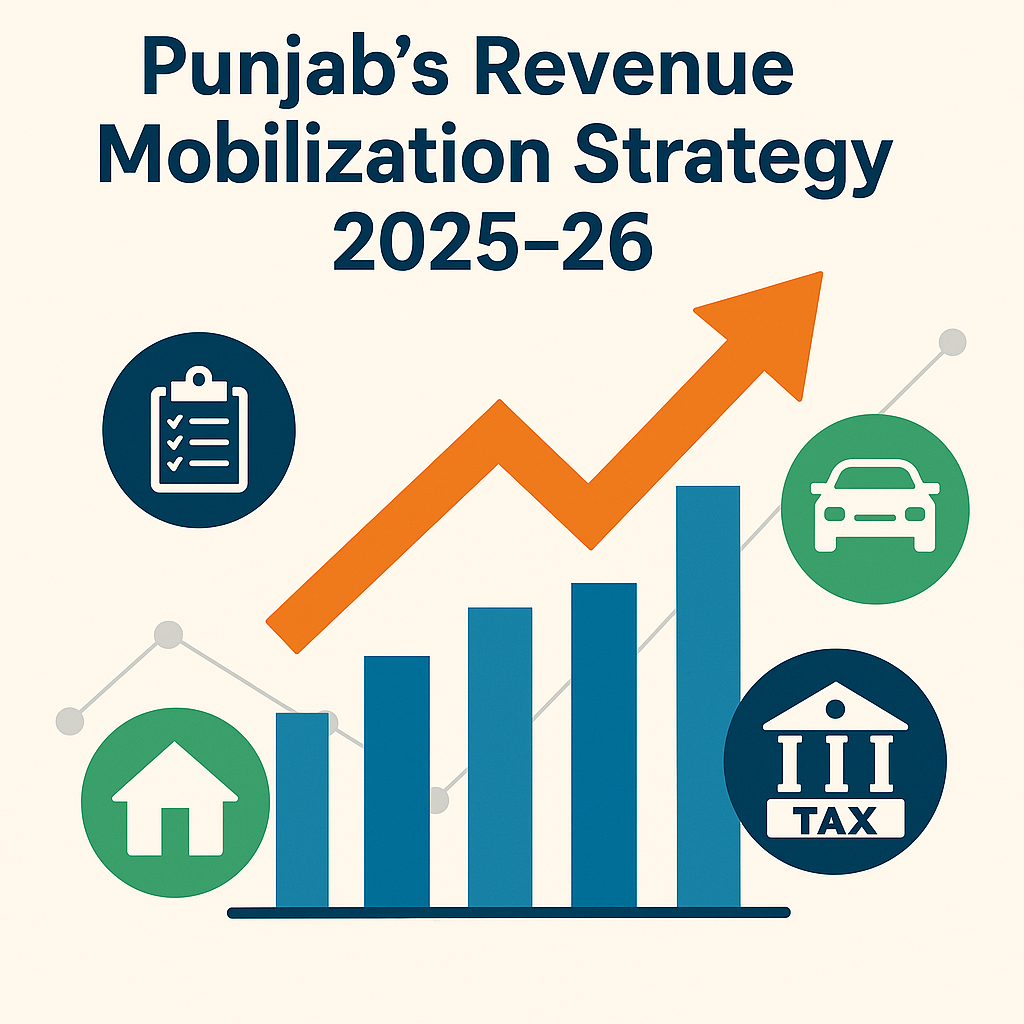
Introduction:
The Government of Punjab’s Revenue Mobilization Strategy (RMS) for FY 2023/24 to FY 2025/26 outlines an ambitious plan to boost Own-Source Tax Revenue (OSTR) from 0.78% of GDP in FY22 to 1.10% by FY26. The strategy hinges on reforms in tax policy, administration, and technology, targeting major revenue streams such as Sales Tax on Services, Property Tax, Motor Vehicle Tax, and Stamp Duty. While the document reflects a structured approach aligned with principles of equity and efficiency, its success depends on overcoming systemic challenges and bridging gaps between theoretical assumptions and practical realities.
Key Components of the Strategy:
1. Sales Tax on Services (STS):
– Transitioning from a Positive List (taxable services) to a Negative List (exempt services) to broaden the tax base.
– Targeting a 24.4% annual growth in STS revenue, aiming to raise its GDP contribution from 0.45% in FY22 to 0.60% by FY26.
2. Property Tax Reforms:
– Shifting from Gross Annual Rental Value (GARV) to capital value-based taxation using DC rates.
– Phasing out exemptions and introducing progressive taxation based on aggregate property value. Property Tax revenue is projected to surge by 74.6% in FY24.
3. Motor Vehicle Tax (MVT):
– Aligning taxes with vehicle value and environmental impact. Targets include a 112% growth in MVT revenue in FY24.
– Addressing inter-provincial competition through national consensus on taxation policies.
4. Stamp Duty and Agricultural Income Tax (AIT):
– Unifying urban and rural Stamp Duty rates, targeting a 30.3% growth in FY24.
– Increasing AIT rates to improve equity, though contributions remain marginal (0.01% of GDP).
5. Administrative Overhauls:
– Automation of tax processes, integration of databases, and enhanced data-sharing with federal agencies.
Critical Shortcomings:
1. Overly Optimistic Growth Assumptions
The strategy projects a 23.2% CAGR for OSTR from FY22–26, far exceeding the historical 14.9% (FY12–22). For instance, Property Tax revenue is expected to grow by 74.6% in FY24, despite a 14.6% historical CAGR. Such leaps assume flawless implementation of reforms, which is improbable given bureaucratic inertia and resistance.
2. Dependency on DC Rates
Property Tax reforms rely on aligning DC rates with market values. However, DC rates are often outdated and politically manipulated. While World Bank programs (PULSE and PRIDE) aim to modernize valuations, past failures in similar initiatives cast doubt on timely execution.
3. Inter-Provincial Coordination Gaps
The Motor Vehicle Tax plan acknowledges jurisdictional arbitrage, where owners register vehicles in low-tax provinces. The proposal for a national working group lacks enforceability, given the historical inability to harmonize policies across provinces.
4. Neglect of Agricultural Income Tax Realities
AIT contributes just 0.01% of GDP, yet reforms remain vague. Raising rates faces political hurdles due to powerful agricultural lobbies. Automation of land records, while necessary, is insufficient without addressing underreporting of farm incomes.
5. Technological and Administrative Bottlenecks
End-to-end automation by FY24 is ambitious, considering Punjab’s limited IT infrastructure. Past delays in federal projects (e.g., FBR’s digitization) highlight risks of over-reliance on technology without capacity building.
Realism of Targets:
The targets are aspirational but hinge on high-risk assumptions:
-GDP Growth: Punjab assumes nominal GDP growth of 14–12% from FY24–26, contingent on national economic stability. Inflation and external debt crises could derail this.
– Policy Compliance: Phasing out exemptions (e.g., for widows in Property Tax) may face public backlash, while enforcing environmental taxes requires emission-testing infrastructure Punjab lacks.
– Data Integration: Seamless data-sharing between federal and provincial agencies remains a pipe dream due to legacy systems and bureaucratic silos.
Historical precedents are sobering. For example, Sales Tax on Services grew at 19.1% annually from FY13–22 but now targets 27.9% in FY24. Without drastic improvements in taxpayer registration and compliance, such leaps are unrealistic.
Recommendations for Improvement :
1. Phased Reforms: Implement the Negative List for Sales Tax gradually to allow businesses to adapt. Similarly, DC rate revisions should be incremental and transparent.
2. Strengthen Inter-Provincial Mechanisms: Legally binding agreements, rather than working groups, could prevent tax evasion in Motor Vehicle Tax.
3. Invest in Capacity Building: Train tax officials in data analytics and modern valuation methods. Partner with tech firms to ensure robust IT systems.
4. Stakeholder Engagement: Launch public awareness campaigns to explain the rationale behind phasing out exemptions and new environmental taxes.
5. Contingency Planning: Develop fallback strategies for revenue shortfalls, such as adjustable tax rates or alternative levies.
Punjab’s Revenue Mobilization Strategy is a commendable blueprint for fiscal sustainability but risks overpromising. While its principles of equity and modernization are sound, the sheer scale of projected growth underestimates implementation challenges. Success will require not just policy changes but also political will, administrative agility, and public buy-in. Without addressing these gaps, the strategy may join a long list of well-intentioned plans that falter in execution.
